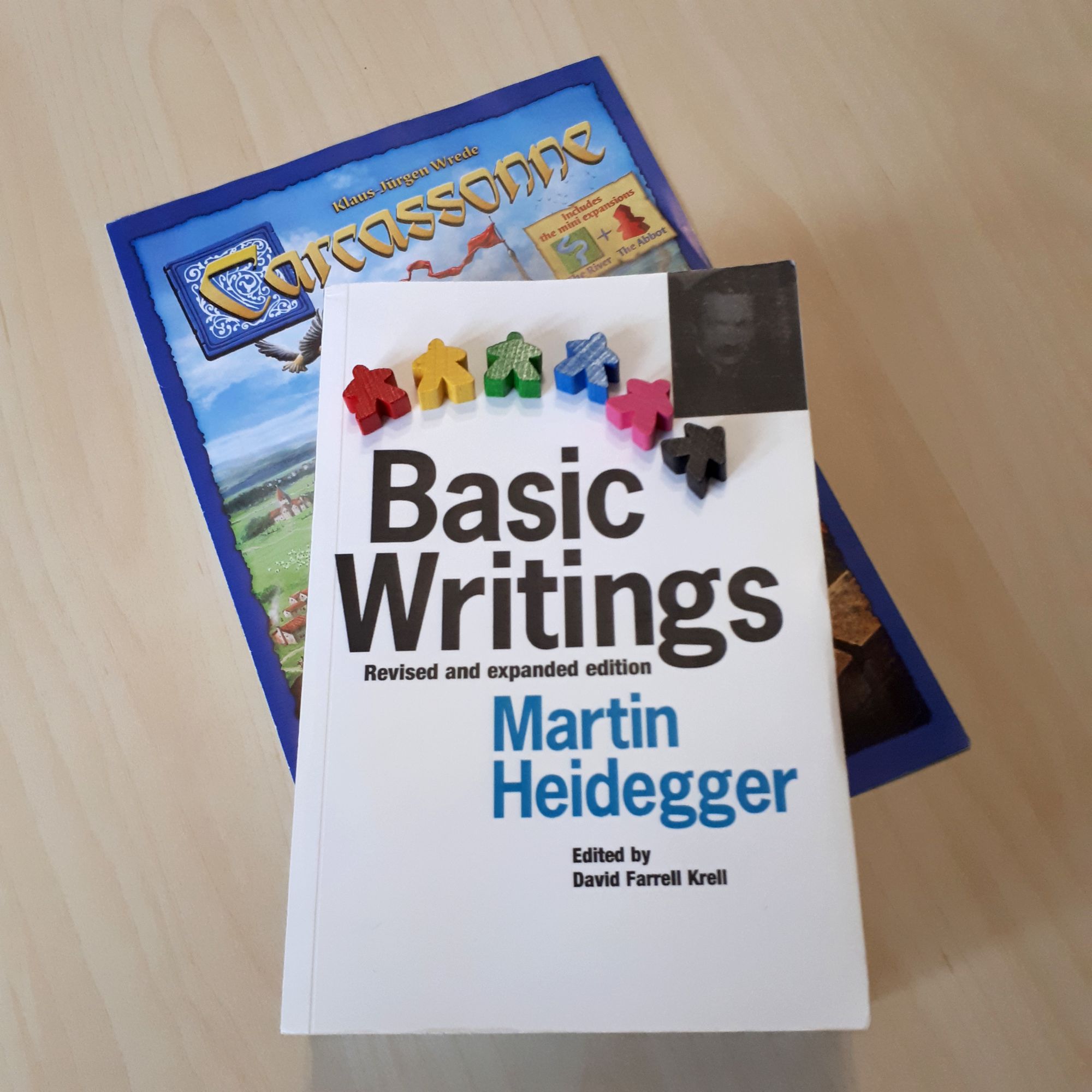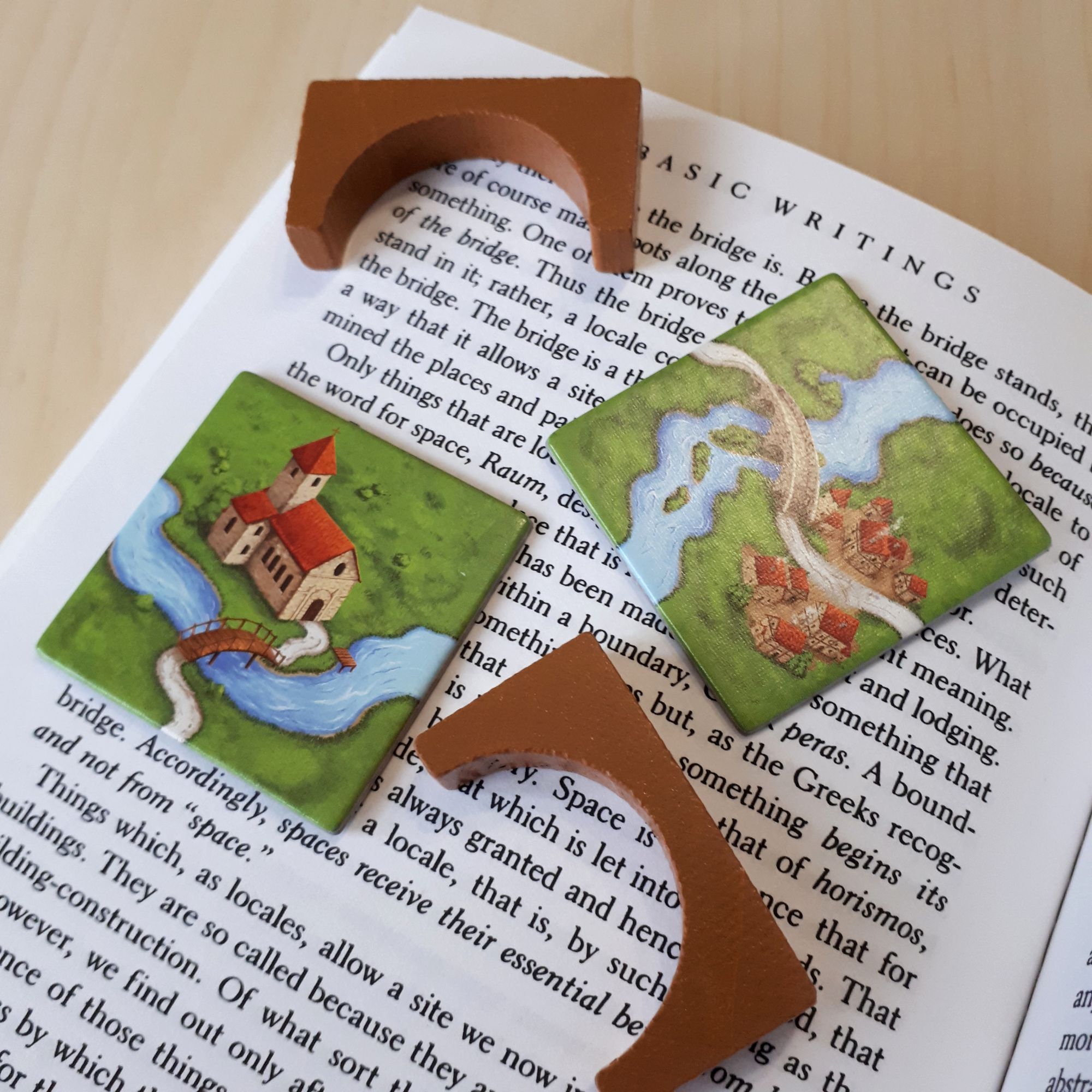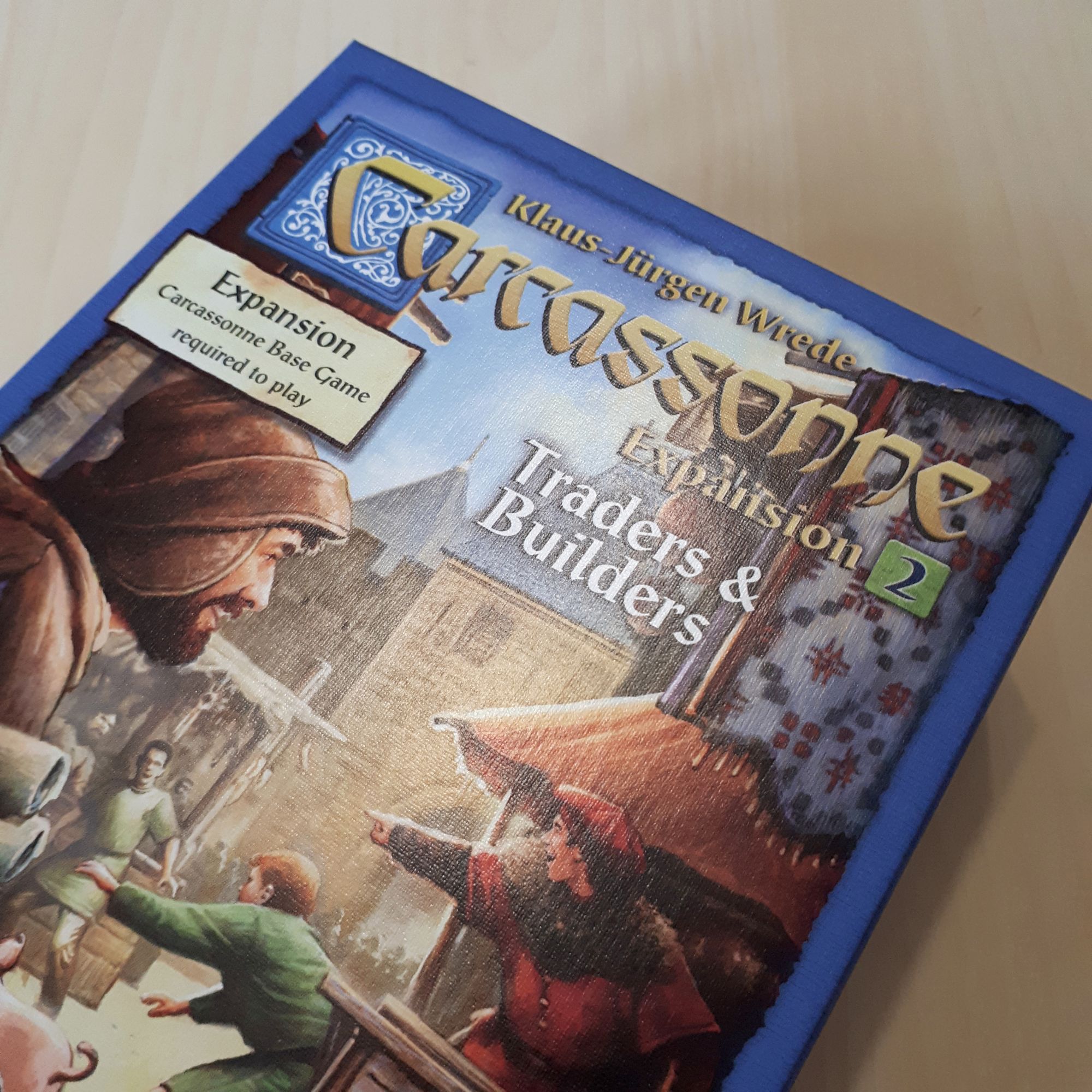Playing | Tile Laying | Rethinking
CONSIDERING CARCASSONNE AS A HEIDEGGERIAN CASE STUDY.
It begins with a spring nestled amongst some rocks. A river flows from it, meandering its way down through green fields and past picturesque flower patches and animal enclosures. Slowly, as it proceeds, the landscape on either side of the river reveals itself, emerging into existence, drawn there with each draw of the tiles. A bridge is built to span the river, allowing for safe movement across its waters, which continue to pass beneath. Now the banks are placed in opposition to each other, and any highwayman attempting to score on the road must pick a side. Here, another bridge runs into a small town; there, it leads to a monastery that is home to solitary green monk. All these locales, drawn at random, are carefully placed. In the distance, another road leads past farmers and inns to a large cathedral city, home to competing knights and traders.
***

The way that the tiled landscape slowly reveals itself is one of the great joys of the classic tabletop game Carcassonne. It is also what allows me to rethink the game in the terms used by philosopher Martin Heidegger in his essay ‘Building Dwelling Thinking’ (1954).
Carcassonne was designed by Klaus-Jürgen Wrede and first published in 2000. It implements an easily accessible tile-laying mechanic. Players take turns to draw square tiles from a shuffled stack. These each depict part of a landscape, and will feature some combination of city, road, monastery, field or river. Subsequent board game expansions have introduced further elements, including travelling bazaars, castles, watchtowers and more. Players place their drawn tiles in such a way that they continue the landscape already created by the tiles placed on previous turns. By the end of the game, a whole world will have revealed itself across the game table.
It is this process of drawing and world building that suggests the game can be rethought in the terms of Heidegger’s essay. I shall explore this view of the game in the analysis that follows, almost – and knowingly absurdly – coming to understand it as a philosophical case study. I briefly consider the linguistic analysis in the first part of Heidegger’s text before looking in more detail at his examples of world building and the creation of space.
***
Heidegger begins his argument in typical fashion, exploring the ways we commonly understand what it is to build and to dwell, and then showing how the original sense of these words has been obscured or lost in language.
He first highlights our common-sense notion that we build buildings so as to dwell in them. Specifically, he explains that whilst not all buildings are dwellings in the narrow sense (importantly, he cites bridges as an example), they do all nevertheless remain, as he puts it, ‘in the domain of our dwelling’.[1] So, he says, a driver is at home on the road. Here, we might already turn to our game box, and to those figures we make highwaymen. These people – these meeples – are placed on roads by players and remain there until the road is complete. This is to say that they dwell there. In the game’s own terms, a highwayman cannot reside anywhere but on a road, and a meeple dwelling anywhere else is not a highwayman (although it is not only highwaymen that dwell on roads – they can be joined by builders).
Heidegger goes on to argue that, contrary to our common understanding, building does not allow for dwelling but is grounded in the notion of dwelling itself. From here, he moves into a mytho-philosophical discussion whose parameters and complexities quickly exceed the rules of our game and therefore also the scope of this present article. Suffice it to say that, at the very simplest level, his concern for dwelling on the blossoming earth is reflected in Carcassonne’s farmers who, once placed, dwell in their positions for the entire game, and in the introduction of elements such as pigs and sheep in the game’s major expansions. Equally, the game also reflects a concern with dwelling under the sky and the changing seasons, or at least its makers can be seen to do so in the stand alone sequel, Carcassonne: Winter Edition (2012).

Heidegger turns in the second section of his essay to the way that the construction of things – buildings and structures – can create locales and space. It is here that his terms help us most to understand the world-building of Carcassonne. This is largely because the philosopher picks as his key example the bridge. This is our critical way in, our link spanning the gap between philosophy and board game. Bridges are essential to Carcassonne, mechanically and in terms of player options. As I’ve already noted, bridges span the river featured in the mini expansions usually used to start the game. These bridges act as the ends of roads and create multiple options for the placing of meeples. Then there are the bridges that feature in the eighth of the game’s major expansions, ‘Bridges, Castles & Bazaars’ from 2010 (my review of which you can read here). These are wooden pieces that, as the rules state, connect ‘the roads of the vast countryside in new and exciting ways’. Specifically, they allow roads to leap over large expanses of field or even over monasteries, and can be joined together to form superstructures.
Heidegger argues that bridges do not sit in the landscape – they help to create it. He says, amongst other things, that a bridge causes the banks to ‘emerge as banks’ and that, crucially, ‘the bridge gathers the earth as landscape around the stream’ (p. 354). All of this is related to his complicated and problematic notion of the ‘fourfold’. Crucially, he says that buildings like bridges create locales and therefore space, neither of which exist before the buildings. He writes: ‘the bridge does not first come to a locale to stand in it; rather, a locale comes into existence only by virtue of the bridge’ (p. 356). For the philosopher, space is defined not as extension – width, length, breadth – but as ‘that for which room has been made’ (p. 356).
This analysis can help us to make sense of our experiences as players of Carcassonne, even when it is shorn of its philosophical context and mythopoetic complexity. When we place a river tile featuring a bridge we are compelled to see the banks as opposed to each other. On which of the opposing banks should I place my meeple? More, bridge tiles make room for certain other tiles to be laid on to the table – those with open road sections. Heidegger’s analysis also allows us to reconsider more broadly the tile-laying game mechanic implemented in the game. Each time a player draws a tile from the stack more of the world is drawn forth. And the positioning of each tile allows room for still further tiles to be drawn and placed, expanding the world still further. The features on every tile – city, monastery, road, field and garden – create what Heidegger would call ‘locales’, sites that bring forth space. The act of playing the game is therefore something akin to what he labels an ‘essential unfolding’ (p. 356).

It worth noting, in conclusion, that Carcassonne does feature its own building mechanic. This was introduced in the second of the game’s major expansions, ‘Traders & Builders’ (2003). This set debuts new meeples who act as builders and who allow a user expanding a city or road on which a builder has previously been placed to draw an additional tile. This is to say that builders allow for more space. They cause more of the world to be drawn around their constructions. Again, this mechanic echoes Heidegger’s analysis. However, the philosopher also points out that building, grounded in dwelling, comes in two forms – cultivation and construction. In the light of this we can claim that the ‘builders’ are not the only builders in Carcassonne. Instead, any meeple put down as a farmer is also a builder, as are those unnamed individuals growing the grapes and crops that produce the wine and grain for the traders. However, to consider them as such would be potentially game breaking.
***
1. Martin Heidegger, ‘Building Dwelling Thinking’, translated by Albert Hofstadter in Martin Heidegger, Basic Writings, revised and expanded edition, ed. by David Farrell Krell (London and New York: Routledge, 1993; repr. 2007), p. 347. All subsequent references to this text will be placed in parentheses immediately after the quotation.
© James Holden 2020. Article first published 12th June 2020.
